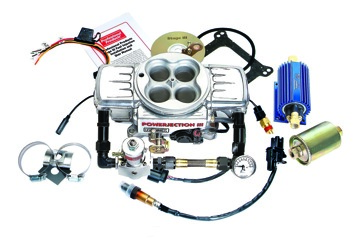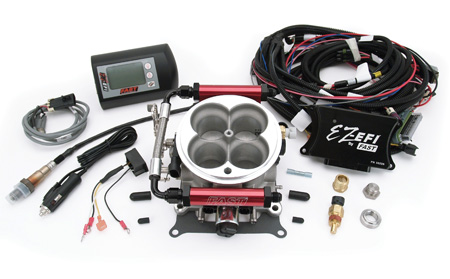These days just about everyone is looking to new technology to solve their problems. In some cases it makes sense: others, not so much.
Take the trusty old carburetor for example: it has been around since the beginning of time (automotive time anyway), and many have predicted its demise, but somehow it keeps coming back to life. There are still many applications and racing classes where the carburetor makes sense and has a dedicated following. It won’t go away say, most experts: in fact, it keeps getting better.
But while computer-controlled fuel systems may offer many advantages over carburetors some experts say they’re not necessarily a universal substitute for a good old-fashioned carburetor that is properly tuned.
We talked to some of the top manufacturers of both carburetors and electronic fuel injection systems to find out the latest offerings and get some of their opinions regarding the endless Carb vs. EFI debate.
According to Adam Cambell of Barry Grant there will always be a place for both EFI and carburetors. “I believe there will always be a place for both carbs and EFI in the performance market regardless of what new innovations come out,” says Cambell. “Both the street and strip guys will continue to use carburetion as it is still relatively simple to tune, work on and diagnose, not to mention the amount of service parts commonly available. Carburetion also makes good power and in many cases will make more horsepower than a comparable EFI set up all without all the additional electronic components and support needed. Carburetion still offers a lot of bang for the buck as most end users can tune their own unlike injection where in most cases it has to go to a qualified tuner and/or a laptop computer is needed. All of this can add up to major costs."
Bill Tichenor of Holly Performance Products agrees: “Carbs will be around for a long time yet. They are very affordable as compared to EFI and still do a great job at delivering power.”
Comp Performance Group’s David Page believes that though we haven’t seen the end of carburetion, EFI will continue to grow in dominance: “In my opinion, the carburetor will never totally go away completely but as we continue to make EFI easier, more accessible, and more affordable, I believe you will see EFI systems on more vehicles and carbs on fewer.”
The carb has a proven advantage over EFI in most applications according to Hilborn Fuel Injection’s Andrew Starr. “We have found that when comparing a common plenum carb to common plenum EFI, the carb typically makes more power,” Starr explains. “This is because the booster of the carb shears the fuel into fine droplets, allowing it to mix and stay suspended in the air column inside the manifold. This reduces the chance of the fuel droplet falling out of suspension and makes for a better burn in the combustion chamber. EFI on the other hand sprays the fuel under pressure, which is not easily picked up by the moving air stream. Coupled with all of the reversion pulses inside the standard common plenum intake, this promotes fuel separation, reducing combustion chamber efficiency.
"The only time we really see a marked increase in power with EFI over carburetion is with the use our individual runner manifold, which offers greater air speed over our common plenum along with the lack of reversion. This also allows combinations with cams that would be considered too large for normal street driving to have excellent low speed torque and excellent part throttle drivability. It is not uncommon for one of our injected engines to make 60+ rear wheel horsepower over a carburetor."
One manufacturer with a little different view of the debate, John Satterfield of DAMbest Carburetors, has just introduced a new line of electronic jets for its line of billet, CNC-machined carbs. Satterfield says that the electronic jet is not electronic fuel injection, it essentially converts your Holley-type carb into one with electronic controls including the accelerator pump to control tip-in.
Carburetors
A lot of racers will make the mistake of putting too big of a carburetor on an application just because the original size sounds small or their buddies are running something larger. This can have negative effects and create performance and tuning issues that may not easily be resolved. Others get caught up in using outdated formulas to try and determine the cfm needed but these charts do not take into account how good or bad the combination of components works as well along with car weight and other important factors including application.
“The key to making a carburetor work properly for an engine combination first comes down to determining the right amount of signal and the ability of the carburetor to pull and atomize fuel correctly, then cfm,” says Barry Grant’s Cambell. “Too big of a carburetor and it will be rich at idle yet lean at wide-open throttle, as it is not breaking the fuel up at idle and does not have enough signal at WOT to pull fuel through the boosters.
“In determining how much cfm is really needed, the end user has to be realistic about the combination and its use and have the rest of their combination already mapped out. Changes in camshafts, converters, heads and intakes can often change carburetor recommendations.
“Don’t get caught up in a manufacturer’s cfm rating, says Cambell. «Instead, look at the booster style, venturi size and butterfly size when determining what the correct size carburetor for the application is.”
Holley’s Tichenor says there is a simple formula for choosing the right size carb: Engine CID x Max RPM/3456. Example 350 cubic inches x 6000 rpm/3456 = 607.63, so a 600 CFM carburetor will be sufficient. This formula figures 100% volumetric efficiency which most engines are not. Holley has a program on its Web site it calls “Carb Selector” which does the calculations for you and also helps you choose between which type of secondaries (vacuum or mechanical) as well as choke type is best for your application.
EFI
Even though EFI systems are run by computers and require an electronic control unit (ECU), there are varying levels of complexity in the systems on the market today. Several manufacturers are aware of the perceptions that EFI is too complicated and have therefore simplified systems for EFI beginners.
“We find that many people are apprehensive about EFI when first considering it,” says Hilborn’s Starr. “As with anything, though, once they get over their initial fears and develop a comfort zone, EFI is not as hard as it seems. Throw in the new advances being made in self-learn technology and even beginners can have the benefits of EFI."
Holley’s new EFI system has been in development for two years on an all-new ECU and will be offered in three levels. The first level is called Avenger EFI and it is intended for street guys with no experience tuning EFI,” says Holley’s Tichenor. “You literally bolt it on, answer some easy questions and it does the tuning for you. The next level system is called HP EFI and it is for the more sophisticated EFI user, but still offers self-tuning as well. The top-end system is called Dominator EFI and is the ultimate race EFI. It has nearly unlimited inputs and outputs, and can control individual cylinder timing, fuel, nitrous, boost control, water methanol, drive-by-wire, electronic transmissions and more.
Professional Products’ Jim Davis says its Powerjection III throttle body style EFI has the unique feature of mounting a miniaturized computer and the MAP sensor directly on the throttle body. He says this eliminates 85 percent of the typical harnessing and vastly simplifies installation. However, despite its simplicity, it is a full featured system.
Experts say that choosing ancillary components for your EFI system are important to consider. “Throttle bodies are selected to provide a sufficient amount of CFM to feed the engine’s displacement at the maximum expected rpm,” says FAST’s Page. “This is basically the same formula used to select a carburetor but the carburetor is much less forgiving to oversizing CFM because the fuel flow at lower rpms in a carb. is directly affected by the vacuum ‘signal’ through the venturi area of the carburetor bore.”
Page continues: “Injectors and fuel pump should be selected based on projected horsepower output. A naturally aspirated gasoline engine will need about .45 pound of fuel per hour per horsepower. For example, a naturally aspirated gasoline engine that makes 675 peak hp will require about 304 pounds of fuel per hour. Divide that number by the number of cylinders and that gives us the fuel need per cylinder. That gives us 38 pounds of fuel per hour needed per cylinder. We do not want the injectors to work over 90% duty cycle under normal conditions so we divide 38 by 90% and that gives us 42 pounds per hour. For example, FAST’s 304208 injectors flow 42 pounds per hour at 43.5 psi, so these would be a good choice. Likewise, you will need a fuel pump and system that will flow 304 pounds per hour plus at least a 10% safety factor so for this application, I would recommend a pump that flows at least 350 pound per hour at 43.5 psi. For the manifold, the selection should be made based on the engine’s general airflow needs.”
Hilborn’s Starr acknowledges that there is a lot of information floating around on the Internet but recommends calling the manufacturer about individual components if you’re unsure of your choice. “The manufacturer is always more than happy to assist so you don’t have to take the chance of receiving poor information from an unreliable source. As part of our service, the technicians at Hilborn design the entire system for the application. This means picking the bore size, fuel pump, line size and all other facets for correct operation and proper performance.”
Whether you choose to build a carbureted engine or an EFI engine, the basics are the same – you are still mixing fuel with air. Where some engine builders are installing EFI on older engines, likewise carbs are being installed on late model engines. Aftermarket suppliers now offer intake manifolds that allow Chevy LS engines and Ford modular V8s that came factory equipped with EFI to be retrofitted with a carburetor. This makes it easier to install these late model engines in older pre-computer cars, street rods and race cars where electronics may not be allowed. 














